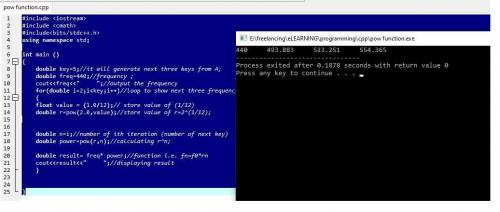
Computers and Technology, 17.01.2020 18:31 erbnichole
Needed in c++ programming!
on a piano, each key has a frequency, and each subsequent key (black or white) is a known amount higher. ex: the a key above middle c key has a frequency of 440 hz. each subsequent key (black or white) has a frequency of 440 * rn, where n is the number of keys from that a key, and r is 2(1/12). given an initial frequency, output that frequency and the next 3 higher key frequencies. if the input is 440, the output is: 440 493.883 523.251 554.365.
note: include one statement to compute r = 2(1/12) using the pow function, then use r in the formula fn = f0 * rn. (you'll have three statements using that formula, different only in the value for n).

Answers: 2


Another question on Computers and Technology

Computers and Technology, 22.06.2019 01:00
)a grad student comes up with the following algorithm to sort an array a[1..n] that works by first sorting the first 2/3rds of the array, then sorting the last 2/3rds of the (resulting) array, and finally sorting the first 2/3rds of the new array. 1: function g-sort(a, n) . takes as input an array of n numbers, a[1..n] 2: g-sort-recurse(a, 1, n) 3: end function 4: function g-sort-recurse(a, `, u) 5: if u ⒠` ≤ 0 then 6: return . 1 or fewer elements already sorted 7: else if u ⒠` = 1 then . 2 elements 8: if a[u] < a[`] then . swap values 9: temp ↠a[u] 10: a[u] ↠a[`] 11: a[`] ↠temp 12: end if 13: else . 3 or more elements 14: size ↠u ⒠` + 1 15: twothirds ↠d(2 ◠size)/3e 16: g-sort-recurse(a, `, ` + twothirds ⒠1) 17: g-sort-recurse(a, u ⒠twothirds + 1, u) 18: g-sort-recurse(a, `, ` + twothirds ⒠1) 19: end if 20: end function first (5 pts), prove that the algorithm correctly sorts the numbers in the array (in increasing order). after showing that it correctly sorts 1 and 2 element intervals, you may make the (incorrect) assumption that the number of elements being passed to g-sort-recurse is always a multiple of 3 to simplify the notation (and drop the floors/ceilings).
Answers: 3

Computers and Technology, 22.06.2019 07:20
Write a pseudocode solution for each of these problems. 1. design a while loop that lets that user enter a number. the number should be multiplied by 10, and the result stored in a variable named product. the loop should iterate as long as product contains a value less than 100. 2. design a do-while loop that asks the user to enter two numbers. the numbers should be added and the sum displayed. the loop should ask the user whether he or she wishes to perform the operation again. if so, the loop should repeat; otherwise it should terminate. 3. design a for loop that displays the following set of numbers: 0, 10, 20, 30, 40, 50 100. 4. design a nested loop that displays 10 rows of # characters. there should be 15 # characters in each row. 5. convert this for loop to a while loop. declare integer count for count = 1 to 50 display count end for 6. find the error in the following pseudocode. declare boolean finished = false declare integer value, cube while not finished display “enter a value to be cubed.” input value; set cube = value ^ 3 display value, “ cubed is “, cube end while
Answers: 2


Computers and Technology, 22.06.2019 19:40
Solve the following javafx application: write a javafx application that analyzes a word. the user would type the word in a text field, and the application provides three buttons for the following: - one button, when clicked, displays the length of the word.- another button, when clicked, displays the number of vowels in the word.- another button, when clicked, displays the number of uppercase letters in the word(use the gridpane or hbox and vbox to organize the gui controls).
Answers: 1
You know the right answer?
Needed in c++ programming!
on a piano, each key has a frequency, and each subsequent ke...
on a piano, each key has a frequency, and each subsequent ke...
Questions


History, 05.10.2019 23:30







History, 05.10.2019 23:30

Mathematics, 05.10.2019 23:30




Mathematics, 05.10.2019 23:30

Physics, 05.10.2019 23:30

English, 05.10.2019 23:30



History, 05.10.2019 23:30




